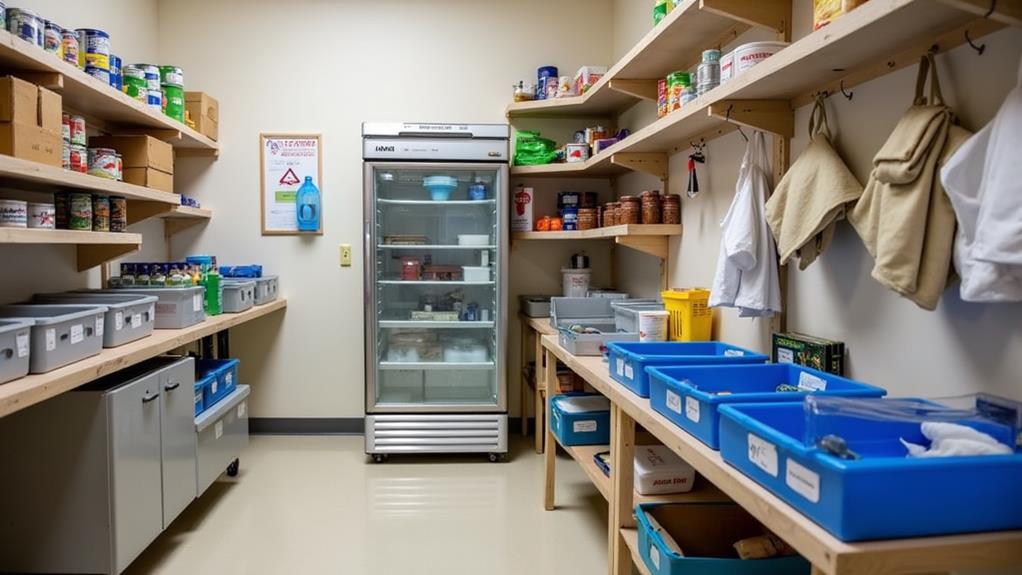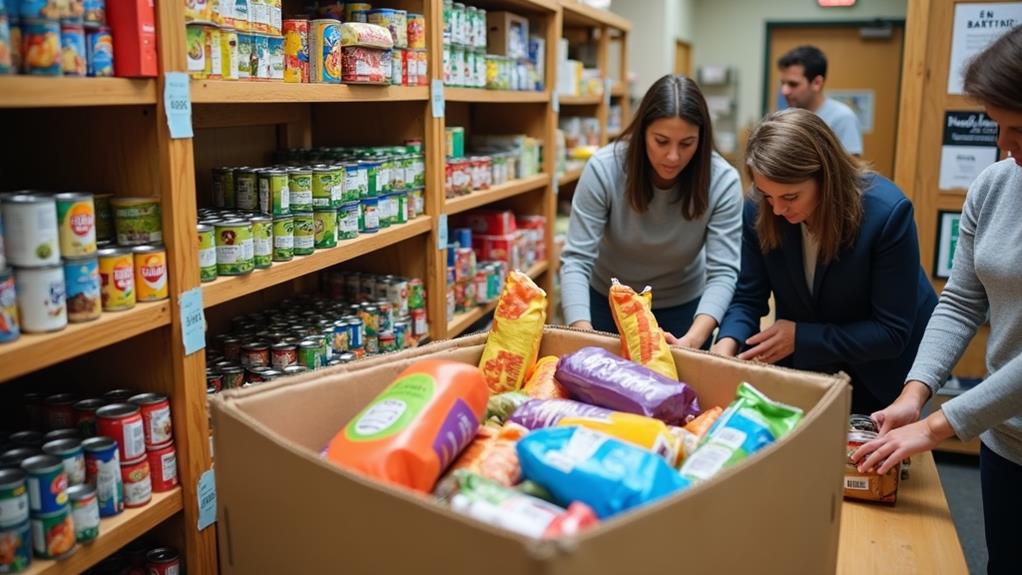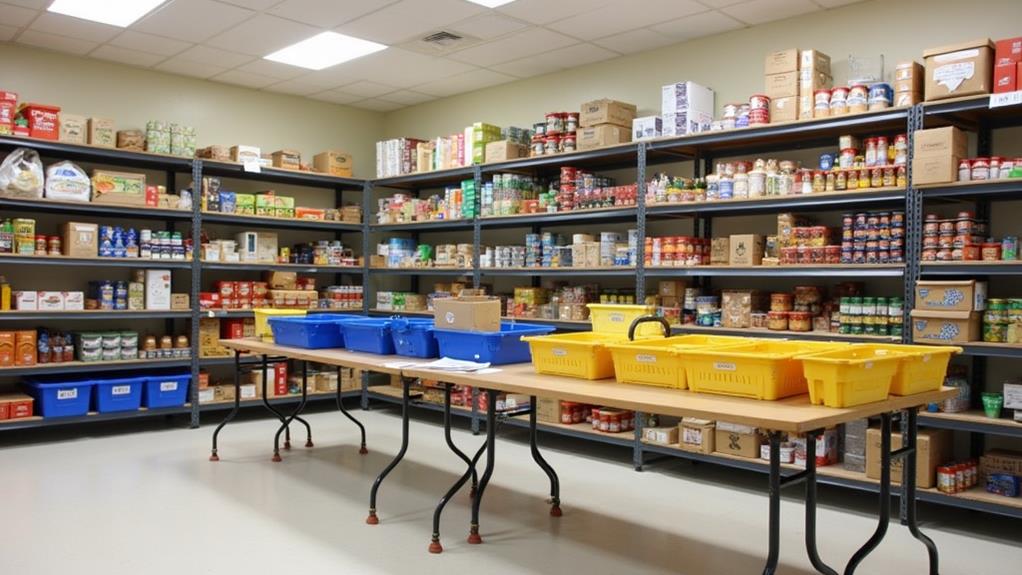Want to make a difference in your community? Organizing a food pantry might be just the thing! Start by evaluating your neighborhood's needs – what kinds of food are most in demand? Next, secure a space and gather resources. You'll need shelves, fridges, and plenty of helping hands! Then, establish clear procedures for operations. How often will you open? Who can access the pantry? Don't forget to recruit and train a team of awesome volunteers – they're the heart of your pantry! Finally, promote your efforts and keep the momentum going. Share success stories, host events, and build partnerships. Ready to roll up your sleeves? There's so much more to explore!
Quick Takeaways
- Assess community needs by engaging with local officials and conducting surveys to understand food insecurity levels.
- Secure a suitable location and necessary resources, including partnerships with food banks and proper storage equipment.
- Establish clear operational procedures, including registration systems and food distribution guidelines.
- Recruit and train volunteers through local networks, providing comprehensive training and clear expectations.
- Promote the pantry's impact and sustainability through community engagement and partnerships with local businesses.
Assess Community Needs
The first step in organizing a community food pantry is to assess community needs thoroughly. You'll want to engage with town officials and local nonprofits to get a clear picture of food insecurity in your area. It's like decluttering your pantry – you need to know what you have before you can organize it, right? Analyze demographic data and conduct surveys to understand the dietary preferences of community members. This'll help you tailor your food collection efforts and guarantee you're providing nutritious food that people actually want.
But don't stop there! Form partnerships with local businesses and organizations to boost your donations. Remember, it takes a village to feed a village. By working together, you'll create a food pantry that truly serves your community's unique needs. Isn't that what it's all about?
Secure Space and Resources
Now that you've got a handle on your community's needs, it's time to focus on securing the right space and resources for your food pantry. Oh, the joy of finding that perfect spot! You'll want a secure space that's accessible and compliant with local regulations. Think of it like organizing your kiddo's messy room – everything needs its place.
Here's what you'll need to evaluate:
- Proper food storage practices (FIFO, anyone?)
- Partnerships with local food banks and grocery stores
- Tables and chairs for distribution
- Cleaning supplies (stored separately, of course!)
Establish Operational Procedures

Establishing operational procedures is like creating a roadmap for your food pantry's success. You'll want to set clear operational hours that work for your community, considering peak demand times like month-end. Don't forget to implement a registration system that respects client privacy while managing food donations effectively.
Next, develop eligibility guidelines and communicate them clearly. How much food can each family receive? It's essential to get this right!
Create a food storage protocol that follows local health regulations. You don't want any spoiled donations ruining your successful food drive!
Lastly, schedule regular meetings with your team. It's a chance to review processes, gather feedback, and make improvements. Remember, your food pantry is a lifeline for many in your community. By nailing these procedures, you're ensuring nonprofit funding is put to good use!
Recruit and Train Volunteers
Volunteers are the lifeblood of any successful community food pantry, so you'll need to recruit and train them effectively. Start by forming a planning committee and designating a coordinator to oversee the process. Use local media and community networks to spread the word about volunteer opportunities. Highlight how their involvement will impact food insecurity in your area. Isn't it amazing how people are most likely to help when they understand the difference they'll make?
Once you've got your team, it's time to get organized:
- Create a volunteer handbook with expectations and schedules
- Schedule thorough training sessions
- Set up a system for tracking contact information
- Establish clear hours of operation for volunteers
Promote and Sustain Impact

With your volunteer team in place, it's time to focus on promoting and sustaining your food pantry's impact. You're not just stocking shelves; you're fighting hunger in your community! Start by sharing your success stories on social media. It's like bragging about your kids' achievements, but instead, you're showcasing how many families you've helped. Host community events to spread the word – think of them as playdates for a good cause. Build partnerships with local businesses; they can be your pantry's godparents, providing a steady supply of food and support. And don't forget to ask for feedback! Just like you'd check if your kids liked dinner, make sure your pantry is meeting everyone's needs. By keeping the community engaged, you'll guarantee your pantry thrives for years to come.
Common Questions
What Are the Steps to Organize a Pantry?
To organize a pantry, you'll need to assess needs, form a planning committee, secure a location, establish storage systems, create a distribution strategy, and conduct outreach. Don't forget to comply with regulations and engage your community throughout the process.
What Are the Three Steps to Organizing a Food Drive With the Houston Food Bank?
To organize a food drive with the Houston Food Bank, you'll need to:
- Register your drive online
- Set dates and logistics
- Use their Toolkit for promotion
Don't forget to focus on nutritious, nonperishable items for donations.
How to Organize a Canned Food Drive?
To organize a canned food drive, you'll need to establish a planning committee, promote the event, set up collection points, specify desired donations, and track results. Don't forget to thank volunteers and donors afterward for their support.
How Do I Become a Food Pantry in Nyc?
You're feeling generous? Fantastic! First, drown in paperwork to become a nonprofit. Then, cozy up to food banks, sniff out community needs, snag a health-code-approved spot, and rally an army of volunteers. Voila! You're NYC's newest food pantry hero.




